Gloucester Tramways
History
A proposal to construct a street tramway within Gloucester was first proposed in 1877 by the Gloucester Tramways Company. The scheme received the city council's blessing on the 8th January 1878, with powers to build and operate a tramway being granted on the 16th August 1878 under the Gloucester Tramways Order, 1878, which was approved by parliament under the umbrella of the Tramways Orders Confirmation (No 1) Act, 1878.
Shortly after the scheme had been approved, the GTCo became a subsidiary of the Imperial Tramways Company, which was registered on the 30th September 1878 to promote, construct and operate tramways within Britain and Ireland.
Construction of the 4ft-gauge horse tramway started on the 16th September 1878, public services commencing 8 months later on the 24th May 1879 over the complete system, bar the branch to the railway stations, which opened a short time later. The system, which was 3.4 miles long, was centred on the Cross, lines running: southwestwards along Southgate Street and Bristol Road to a terminus at Theresa Street; northwestwards along Westgate Street to a terminus at St Nicolas Church; northeastwards along Northgate Street to its junction with Worcester Street, where a line branched off northwards to terminus at Denmark Road, Kingsholm, the main line continuing eastwards along London Road to a terminus at the Fleece Inn at Wotton; and southeastwards along Eastgate to Clarence Street, where a short branch wound its way northeastwards to the railway stations, the main line continuing southeastwards along Barton Street to a terminus in India Road.
The tramway was not a financial success, making a large loss in its first year, which resulted on the withdrawal of services on the Stations and Westgate branches, and the removal of the track. Matters did not, however, improve, the ITCo clearly deciding that it had had enough, offering the tramway for sale on the 23rd April 1881.
The tramway was bought by the Bristol and Bath Tramways Company, which quickly set up a subsidiary — the City of Gloucester Tramways Company — to operate it. It is possible that the tramway was closed for a time (this is unclear), though it may well have just had a ceremonial re-opening on the 2nd July 1881 when the new company took over. The new owners managed to turn the tramway around, making a profit and paying regular dividends.
On the 6th July 1895, the company acquired powers — under the City of Gloucester Tramways Order, 1895 (approved via the Tramways Orders Confirmation [No 1] Act, 1878) — to build extensions to the system. An extension along Bristol Road from Theresa Street to Tuffley Avenue was opened on the 10th July 1897; this took the horse tramway to its final size of 4.45 miles.
In late 1899, the company applied for a Light Railway Order to extend the system outside the city boundary, and to use electric traction. For some reason, the council was not consulted ahead of this move, a step that would ordinarily have earned a tramway company the undying enmity of a local authority. Luckily for the company, this did not happen in Gloucester, possibly because it was willing to sell the tramway to the corporation, or alternatively, to operate it itself, with electricity being supplied by the corporation.
Unfortunately, an agreement on a price, either for electricity or for the tramway, could not be reached, so the LRO was effectively stalled for the best part of two years. Negotiations recommenced at the end of 1901, the company being in a relatively strong bargaining position, as the corporation did not have the power to compulsorily purchase the tramway until 1911. A price was eventually agreed, the corporation taking ownership on the 30th September 1902, with the company agreeing to operate it until the corporation took over on the 1st January 1903.
The corporation's Light Railway Order now ran into opposition from Gloucester County Council, which did not want the corporation building a tramway in its area (i.e., the planned line out from the city boundary to Hucclecote and Brockworth). Agreement between the two authorities was, however, eventually reached, powers to reconstruct and extend the tramway being granted on the 7th August 1903, under the Gloucester Corporation Light Railways Order, 1903. On the same day, Gloucester County Council acquired powers to construct their portion of the system — under the County of Gloucester (Gloucester and Brockworth) Light Railways Order, 1903 — the operation of which would be leased to Gloucester Corporation.
Construction of the new electric tramway, which was to the narrower gauge of 3ft 6ins, commenced in November 1903. The corporation-operated horse-tram services were gradually withdrawn as reconstruction proceeded, the last horse tram of all running on the 17th March 1904.
Uniforms
Photographs of the first operator of Gloucester's horse-tramway system — the Gloucester Tramways Company (1879-1881) — appear not to have survived, so it is currently not possible to say whether staff wore uniforms. However, given that the GTCo was a subsidiary of the Imperial Tramways Company, and staff of that company's other tramway subsidiaries were not usually issued with uniforms, it seems highly likely that drivers and conductors of the GTCo wore informal attire.
Photographs of the GTCo's successor — the City of Gloucester Tramways Company (1881-1902) — have only survived from relatively late on. However, these clearly show tramcar crews wearing a variety of coats, suggesting that the garments were self purchased. Neither the coats nor the caps bore insignia. There is a possibility that the caps were provided by the company, or alternatively, that the company required its tramcar crews to wear a specific type of cap, purchased at their own expense.
A single photograph has survived from CofGTCo days that shows an inspector. Although his smart single-breasted overcoat would appear to lack badges of any kind, his kepi-style cap does bear a large oval badge (of unknown pattern). This was possibly of embroidered cloth given the lack of a reflection in the photograph.
Further reading
For more information on Gloucester's horse tramway system, see: 'The Gloucester Horse Tram' by R Wilson and R Jones; Gloucester Society for Industrial Archaeology Journal 2008, p18-30.
Images
Horse tram drivers and conductors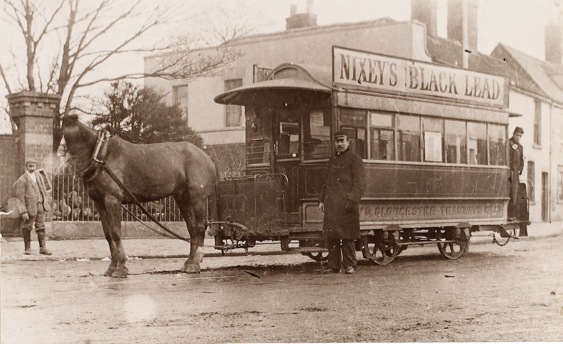
A driver and a conductor stand with City of Gloucester Tramways Company Horsecar No 10 at the India House — photo purportedly taken in 1897. Photo courtesy of the Stephen Howarth Collection.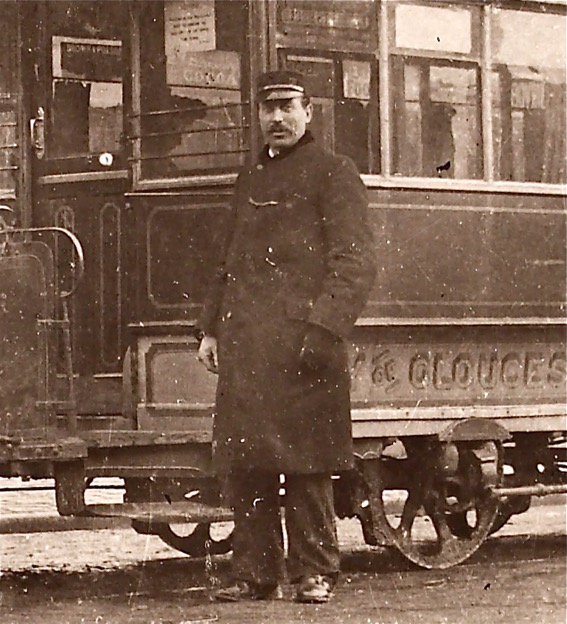
An enlargement of the above photograph showing the driver. He is wearing a greatcoat and a drooping-peak cap, all seemingly devoid of insignia.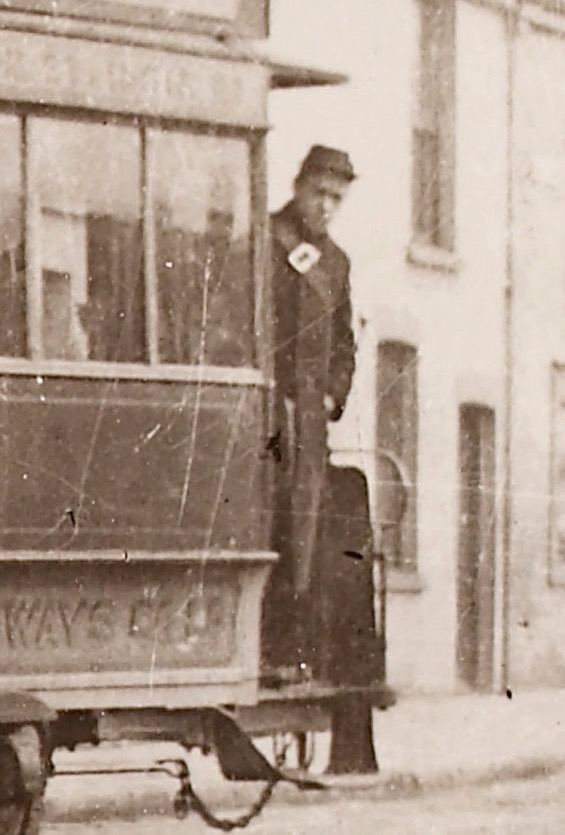
Another enlargement of the above photograph, this time showing the conductor, who would appear to be wearing a long single-breasted greatcoat and a kepi-style cap. The fact that the hat is a different type to that worn by the conductor, suggests that the caps, and almost certainly the coats too, were self purchased.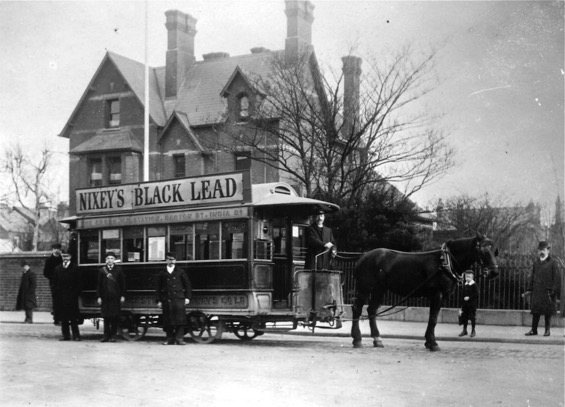
Another shot of Horsecar No 10 — photo undated, but judging by the battered state of the vehicle, probably taken around the turn of the century. Photo courtesy of the Tramways and Light Railway Society, with thanks to David Voice.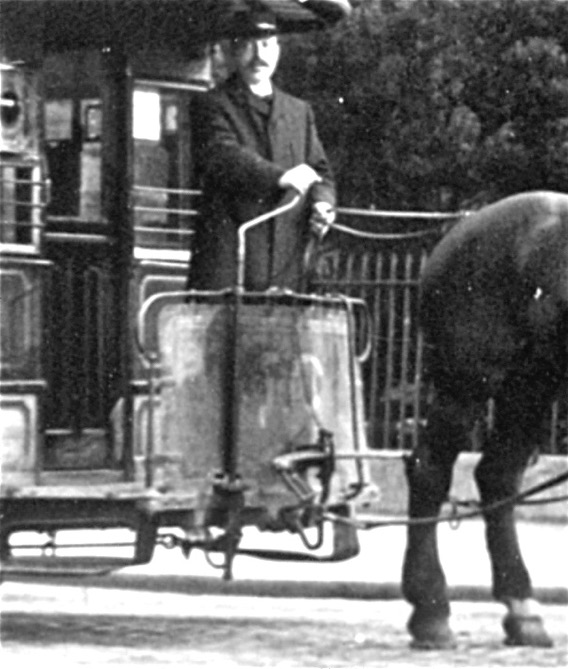
An enlargement of the above photograph showing the driver, who would appear to be the same individual as in the previous shot of No 10. Perhaps unsurprisingly, he is wearing the same style of coat and cap as in the previous photograph.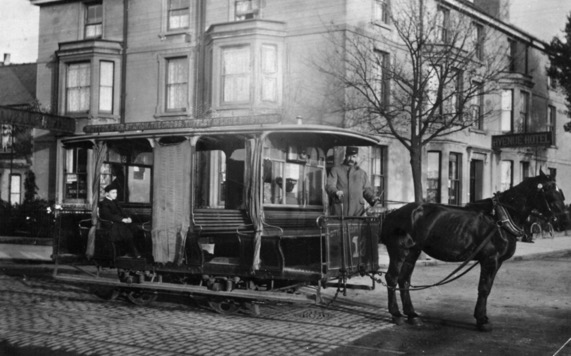
CofGTCo Horsecar No 13 stands outside the Avenue Hotel on Bristol Road — photo undated, but probably taken around the turn of the century. Photo courtesy of the Tramways and Light Railway Society, with thanks to David Voice.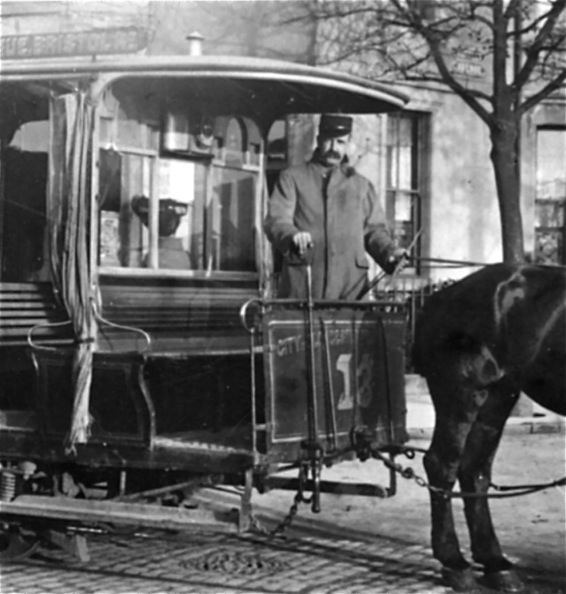
An enlargement of the above photograph showing the driver. He is wearing a light-coloured greatcoat/overcoat and a drooping-peak cap, all devoid of insignia. The difference in the colour of the coat, compared with other photographs, suggests that they were self-purchased rather than company issued.
Senior staff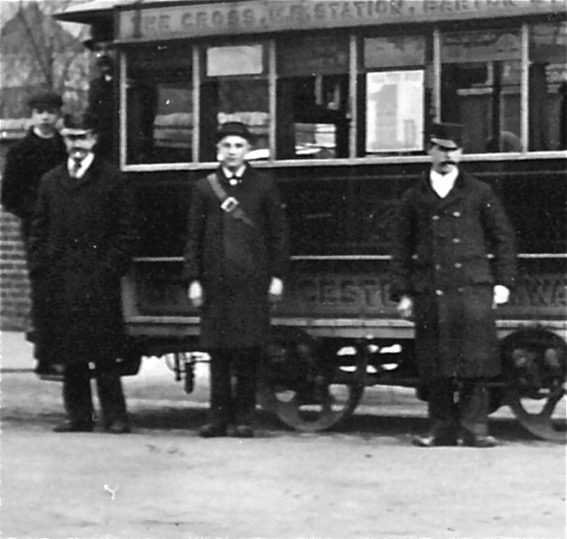
An enlargement of the photograph of Horsecar No 10 above showing three of the tramwaymen. The individual in the middle, with the cash-bag strap is clearly a conductor. Although the grade of the men flanking him is unclear, the fact that the individual on the left has a large oval badge on his kepi-style cap suggests that he may well be an inspector. Photo courtesy of the Tramways and Light Railway Society, with thanks to David Voice.